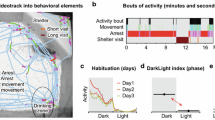A method for partitioning environmental correlations into two distinct sources of covariation—lifetime rearing effects and idiosyncratic stimulus events occurring during testing (“noise”)—is presented. The method, which is based on structural equation modeling of repeated tests, is demonstrated using correlations obtained from pairs of sessions in an Open Field Test and in a Light–Dark Test. Heritabilities of most behaviors are low, but genetic correlations between- and within-test sessions are high and thus substantively influence phenotypic correlations, including test–retest reliability. Testing “noise” is usually the primary source of environmental covariance among pairs of measures, although some instances of rearing environment being the sole source of E correlations were observed. Effects of Session 1 testing and/or the additional experience between S1 and S2 test sessions produce some significant differences between S1 and S2 within-session correlations, but these are usually not large. Although varying in size, the genetic, the rearing environment and the test environment correlations between a pair of variables were always consistent in sign. The analysis demonstrates the value of incorporating some of the contemporary research and analytic strategies used in the human individual differences field into animal studies.
Similar content being viewed by others
References
J. L. Arbuckle W. Wothke (1999) Amos 4.0 users guide SmallWaters Chicago
D. T. Campbell D. W. Fiske (1959) ArticleTitleConvergent and discriminant validation by the multitrait-multimethod matrix Psychol. Bull. 56 81–105
P. L. Chi (1937) ArticleTitleStatistical analysis of personality rating J. Exp. Educ. 5 229–245
D. S. Falconer (1989) Introduction to quantitative genetics EditionNumber3 Longman Essex
J. P. Hegmann J. C. DeFries (1968) ArticleTitleOpen-field behavior in mice: genetic analysis of repeated measures Psychon. Sci. 13 27–28
J. P. Hegmann J. C. DeFries (1970) ArticleTitleAre genetic correlations and environmental correlations correlated? Nature 226 284–286
N. D. Henderson (1967) ArticleTitlePrior treatment effects on open field behavior of mice—A genetic analysis Anim. Behav. 15 364–376
N. D. Henderson M. G. Turri J. C. DeFries J. Flint (2004) ArticleTitleQTL analysis of multiple behavioral measures of anxiety in mice Behav. Genet. 34 267–293
Jöreskog, K. G., and Sörbom, D. (1996). Structural equation modeling. Workshop presented for the NORC Social Science Research Professional Development Training Sessions. Chicago, IL.
D. A. Kenny J. S. Berman (1980) ArticleTitleStatistical approaches to the correction of correlational bias Psychol. Bull. 88 288–295
M. Lynch B. Walsh (1997) Genetics and analysis of quantitative traits Sinauer Sunderland, MA
J. J. McArdle R. W. Woodcock (1997) ArticleTitleExpanding test–retest designs to include developmental time-lag components Psychol. Methods 2 403–435
M. C. Neale S. M. Boker G. Xie H. H. Maes (1999) Mx: Statistical modeling EditionNumber5 Department of Psychiatry, Virginia Commonwealth University Richmond, VA
N. Schmitt D. M. Stults (1986) ArticleTitleMethodology review: analysis of multitrait-multimethod matrices Appl. Psychol. Meas. 10 1–22
E. L. Thorndike (1920) ArticleTitleA constant error in psychological ratings J. Appl. Psychol. 4 25–29
M. G. Turri S. R. Datta J. DeFries N. D. Henderson J. Flint (2001a) ArticleTitleQTL analysis identifies multiple behavioral dimensions in ethological tests of anxiety in laboratory mice Curr. Biol. 11 725–734
M. G. Turri N. D. Henderson J. C. DeFries J. Flint (2001b) ArticleTitleQuantitative trait locus mapping in laboratory mice derived from a replicated selection experiment for open-field activity Genetics 158 1217–1226
C. E. Werts R. L. Linn (1970) ArticleTitleA general linear model for studying growth Psychol. Bull. 73 17–22
Author information
Authors and Affiliations
Corresponding author
Rights and permissions
About this article
Cite this article
Henderson, N.D. Use of Repeated Measures to Interpret Genetic and Environmental Correlations in Animal Research. Behav Genet 35, 313–322 (2005). https://doi.org/10.1007/s10519-005-3223-2
Received:
Accepted:
Issue Date:
DOI: https://doi.org/10.1007/s10519-005-3223-2




